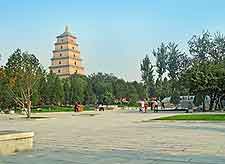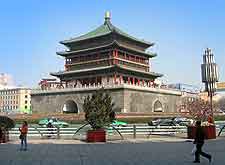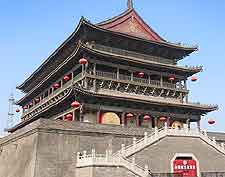Xian History Facts and Timeline
(Xian, Shaanxi, China)

The current capital of China's Shaanxi province is one of the country's oldest and most important cities. The history of Xian (Xi'an) reflects more than three millennia of Chinese culture and heritage, and the city is one of the Four Great Ancient Capitals of China.
As the eastern terminus of the ancient Silk Road, it has been a vital link to the world since the earliest days of Chinese rule, and today serves as one of China's top travel destinations.
The Qin Dynasty
As far back as the 11th century BC, Xian was the capital of the Zhou Dynasty and a major centre of politics and culture. The Warring States Period in Xian history saw the Qin Dynasty emerge as the rulers of all China in 221 BC, and they established their first national capital just to the north-west of modern Xian. More than 270 palaces and temples were built during the Qin Dynasty.
The first emperor of the Qin, Qin Shi Huang, is the man responsible for creating the Terracotta Army in his mausoleum, which today is one of China's most popular and impressive attractions, serving as a UNESCO World Heritage site. When the Han Dynasty took over from the Qin in 202 BC, its ruler, Liu Bang, built the Changle Palace where today's Xian is located. Liu Bang is considered to have built the modern version of the city.

A Powerhouse
Liu Bang of the Han Dynasty was responsible for building many of the present-day landmarks, including Weiyang Palace and the original city wall that still largely exists today. Despite several centuries of Chinese unrest that followed Xian's founding, the city remained a valued capital.
When the Sui Dynasty united China again in 582 AD, it built its new capital a little to the south and incorporated the original city into its grand plans. At the time, the city, known as Daxing, was the world's largest walled city, covering a total area of 84 square km / 32 square miles.
The Tang Golden Era
When the Tang took over China, they renamed this massive city Chang'an, which eventually led to its modern spelling of Xian, or Xi'an. This was an era of relative peace in China, when Buddhism flourished and calligraphy was invented. Xian is home to a large number of original Buddhist pagodas and shrines from the Tang era.
This was a time when Xian was at the eastern end of the great Silk Road, putting it at the crossroads of trade and culture between both the East and West for centuries. For a long period, the city was China's undisputed centre of culture and commerce.
When the Tang era ended in 904 AD, Xian fell with it, and the city went into a long period of decline. For nearly 1,000 years the city vanished from the history books of China, until the remarkable discovery of Emperor Qin's mausoleum, guarded by its army of terracotta soldiers. Ironically, it was he who originally ordered the burning of most of the city's records to purify his style of governance.

Rediscovering its Heritage
It is only in recent years that Xian has rediscovered its rich history and heritage, and along with it is a new impetus towards economic growth. With amazing finds like the buried Terracotta Warriors, the city has been able to market itself as one of China's top tourist attractions.
Xian is also a thriving centre of trade and manufacturing, with hundreds of different markets and factories making, selling and buying all the things that keep China's engine humming.
 The current capital of China's Shaanxi province is one of the country's oldest and most important cities. The history of Xian (Xi'an) reflects more than three millennia of Chinese culture and heritage, and the city is one of the Four Great Ancient Capitals of China.
The current capital of China's Shaanxi province is one of the country's oldest and most important cities. The history of Xian (Xi'an) reflects more than three millennia of Chinese culture and heritage, and the city is one of the Four Great Ancient Capitals of China.
